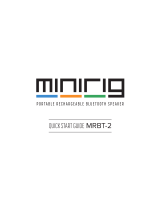
4
8. Cue Button – If no cue point is set, pressing the button will force a restart from the beginning of the track.
Press the “CUE SET” button to set a new cue point and the “CUE” button will illuminate. Press “CUE” to play
from this new cue point.
9. Cue Set – Sets the cue point during playback or when paused.
10. Hot Cue 1, 2, 3 – Sets a Hot Cue during playback or while paused. These are similar to regular cue points,
except that when the buttons are pressed, the unit will instantly jump to the defined point and begin playing.
When the button is pressed again, playback will resume from the set Hot Cue. When Shift + Hot Cue are
pressed, the Hot Cue will be deleted. Button will illuminate when a cue point has been set.
11. Jog Wheel – Capacitive Touch-sensitive jog wheel manipulates the audio when the wheel is touched and then
moved. The mode applied will decide the effect that the jog wheel has. When in “Scratch” mode is engaged,
the wheel will allow users to grab and move audio slowly during play. When in “Search” Mode touching an
moving the wheel will force rapid movment throught the song. The non-touch-sensitive outer wheel will act as
pitch bend when a song is playing.
12. Scratch/Search – Controls the behavior of the platters. When not active, the platter will function as Pitch Bend.
When active, the platter will have the ability to scratch. Pressing Shift+Scratch/Search will enter SEARCH
mode.
13. Pitch Fader – Controls the tempo (speed) of the individual decks.
14. Pitch Down – Momentarily reduces the speed of the track when pressed and held.
15. Pitch Up – Momentarily increases the speed of the track when pressed and held.
16. Sync – Controls the behavior of the BPM sync of boths decks. When engaged, the selected deck will
automatically adjust the tempo/speed of the track to the same BPM that is set on the other deck. To manually
adjust the BPM and exit Sync mode, move the pitch fader for
the deck.
17. Loop in – This will set the beginning of a loop when in manual
looping mode. When Shift + Loop in are pressed, Algoriddim
djay will perform a 1/2-beat loop roll.
18. Loop Out – This will set the end of a loop when in manual
looping mode. When Shift + Loop Out are pressed, Algoriddim
djay will perform a 1-beat loop roll.
19. Reloop – This will re-engage the previously exited loop. When
Shift + Reloop are pressed, Algoriddim djay will perform a 2-
beat loop roll.
20. Auto Loop – Places a loop based on the autoloop length. When Shift + AUTO LOOP are pressed, Algoriddim
djay will perform a 1/16-beat loop roll.
21. Loop x1/2 – If a loop is playing, reduces the current loop length by half. If a loop is not playing, the will set the
Autoloop loop length. When Shift + Loop x1/2 are pressed, Algoriddim djay will perform a 1/8-beat loop roll.
22. Loop x2 – If a loop is playing, multiplies the current loop length by 2. If a loop is not playing, the will set the
Autoloop loop length.. When Shift + Loop x2 are pressed, Algoriddim djay will perform a 1/4-beat loop roll.
23. FX Parameter – Controls the parameter of the selected FX.
24. FX On/Off – Engages and disengages the selected FX.
Note: You can run up to 2 effects at a time if using either iPad 2 or iPad (3rd generation).
25. Filter – Controls the amount of the filter on the assigned channel.
26. Channel Volume – Adjusts the volume of the individual channels.
27. Crossfader – Controls the mix blend between the two decks.
28. High EQ – Controls the treble frequencies for the individual channels.
29. Mid EQ – Controls the mid range frequencies for the individual channels.
30. Low EQ – Controls the bass frequencies for the individual channels.
31. Master Volume – Adjusts the Master volume of the balanced XLR outputs and RCA outputs. (Note: When
using AirPlay or Bluetooth, adjust the master volume in djay’s Settings menu.)
32. PFL – Engages Cue Monitor for the selected channel.
33. Record – Starts recording of the performance in the software.
Note: Loop rolls are momentary
commands which occur when the
associated combination keys are being
held. The deck’s audio source still plays
in time while the loop roll occurs and
will be heard again when the loop roll is
released.







